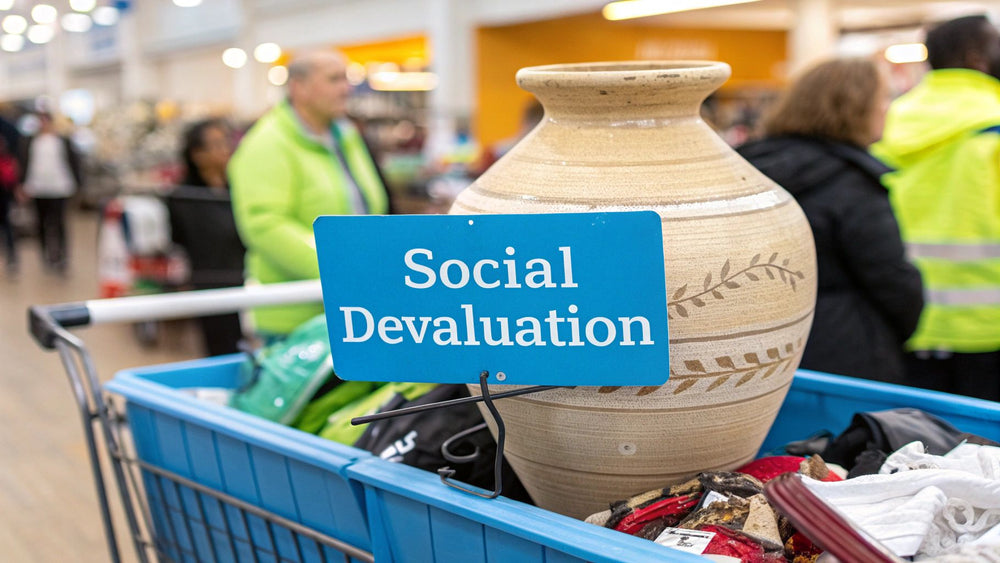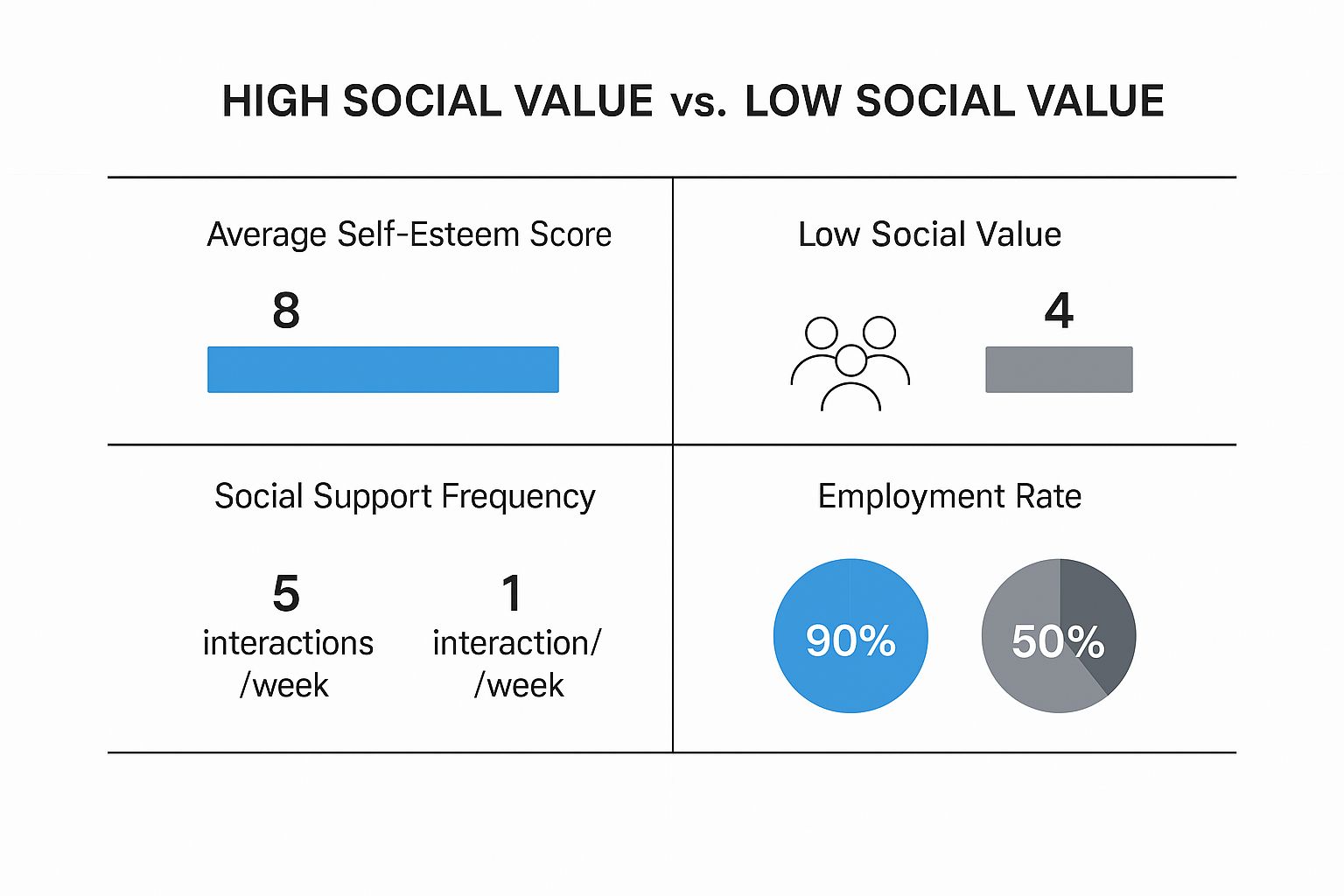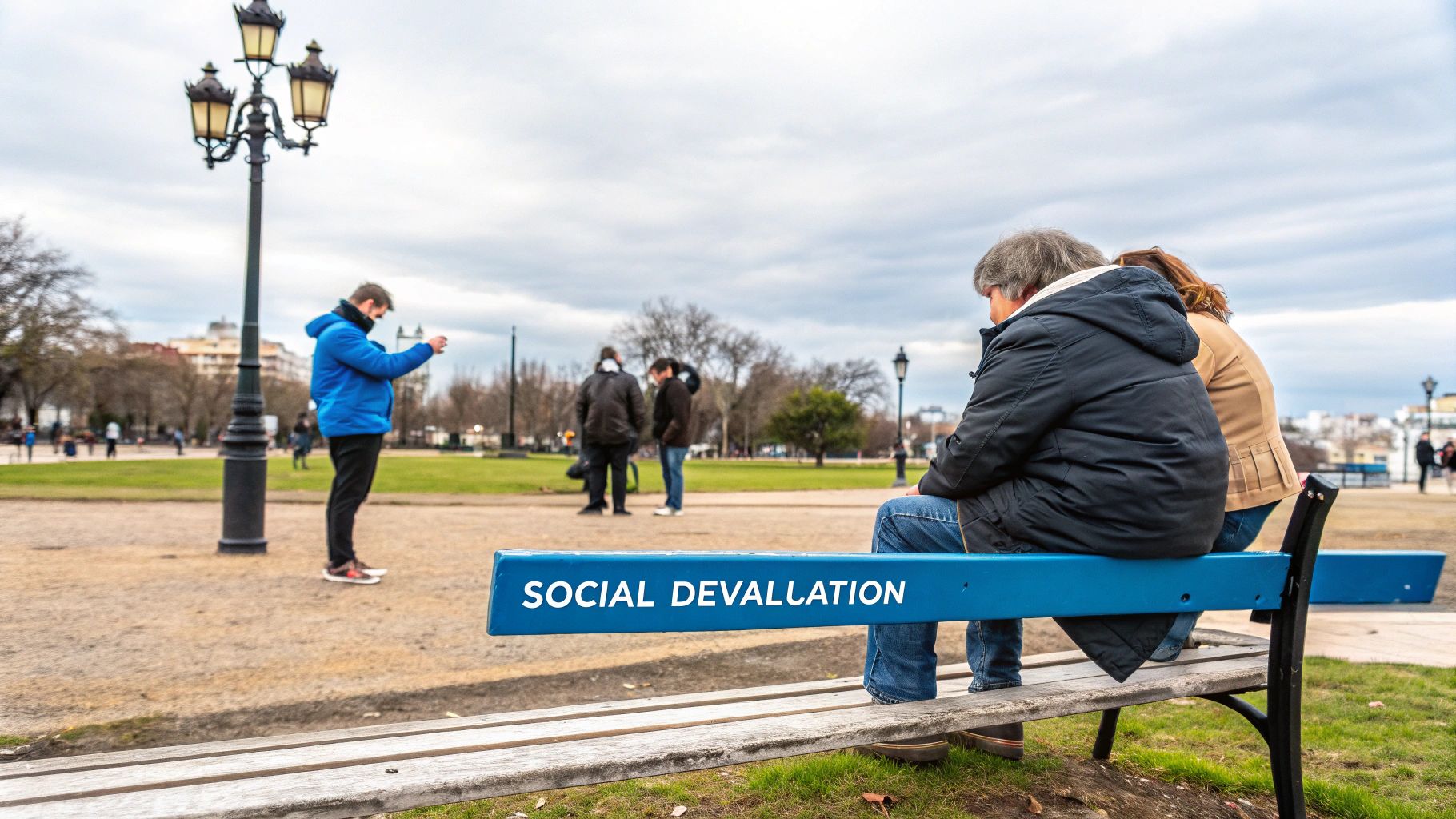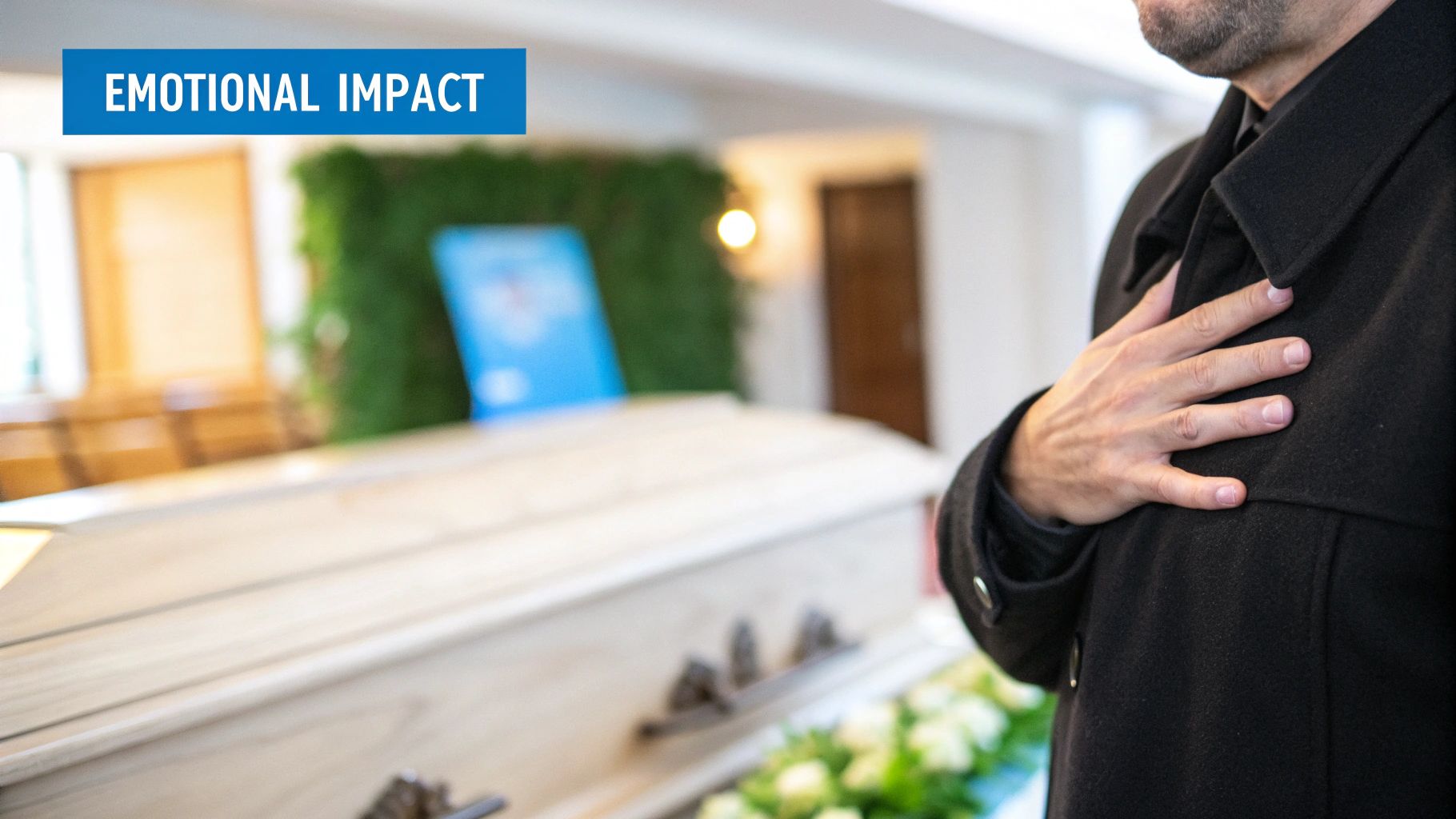Social Devaluation Meaning: What It Means & Its Impact

Social devaluation is a powerful, often invisible, force in our society. It's the process where certain groups or individuals are treated as if they are worth less than others, which in turn limits their access to the good things in life and overshadows their true potential. This happens when negative stereotypes lead to real-world exclusion, affecting everything from a person's self-worth to their job prospects.
What Does Social Devaluation Actually Mean?
Think of it like this: imagine a beautifully handcrafted chair being overlooked at an auction and relegated to a dusty corner, simply because it doesn't match the modern, mass-produced furniture on display. The chair's intrinsic quality and value haven't changed, but the perception of it has. This is the heart of what social devaluation is. It’s not about a person’s actual abilities or character; it’s about how they are perceived by the wider community.
This process often pushes people into negative, one-dimensional roles because of attributes like disability, age, or socioeconomic status. Instead of being recognised as a unique individual—a colleague, a neighbour, a friend—they might be unfairly labelled as a "burden," a "patient," or someone to be pitied.
These aren't just abstract ideas. These labels build very real barriers, making it harder for someone to get involved in their community, make friends, find meaningful work, or simply be seen for who they are.
It creates a damaging cycle. The initial negative perception leads to fewer opportunities, which then seems to "confirm" the original stereotype. For example, if an employer assumes a person with a disability is incapable of a certain job, they won't get hired. That lack of employment is then wrongly used as evidence that people with disabilities can't work, reinforcing the whole cycle.

The difference between being valued and devalued by society is stark. To give you a clearer picture, let's break down how these two opposing experiences play out in everyday life.
Social Devaluation vs Social Valuation at a Glance
| Characteristic | Social Devaluation (Negative Perception) | Social Valuation (Positive Perception) |
|---|---|---|
| Identity | Defined by their "problem" or disability. | Seen as a unique individual with many roles. |
| Community Role | Client, patient, or recipient of charity. | Contributor, neighbour, friend, colleague. |
| Opportunities | Limited access to education, work, and social life. | Full access to life's opportunities. |
| Relationships | Mostly with paid staff or other devalued people. | A rich network of varied, freely-given relationships. |
| Expectations | Low expectations for growth and achievement. | High expectations for personal growth and success. |
This table really highlights the two different worlds a person can inhabit based on how society chooses to see them.
The impact is clear: being devalued often leads to social isolation, lower self-esteem, and much poorer life outcomes, especially in areas like employment. The key to turning this around is connection. Purposefully building community ties and participating in group settings can restore a person's valued role. You can explore some great ideas for inclusive activities that help build social skills in our guide.
Ultimately, grasping what social devaluation is—and calling it out when we see it—is the first, most crucial step toward building a society that recognises the inherent dignity and worth of every single person.
The Hidden Wounds of Being Devalued

Knowing the definition of social devaluation is one thing, but feeling its sting is another entirely. The constant, quiet messages from society suggesting you're "less than" can wear a person down, leaving deep-seated feelings of isolation, shame, and a fractured sense of self.
Think about what it’s like to be defined not by who you are—your personality, your talents, your ambitions—but by a single label, like your disability, age, or background. It's draining. Over time, this can lead to a devastating phenomenon known as internalised oppression.
This is the point where a person starts to absorb and believe the negative stereotypes society throws at them. They might begin to second-guess their own abilities, feel undeserving of good things, or even start seeing themselves as a problem.
"Internalised oppression is the quiet acceptance of society's negative judgement. It's when the external voice of devaluation becomes your own internal critic, limiting your potential from the inside out."
The impact goes far beyond just hurt feelings; the consequences are real and incredibly harmful. The psychological weight of being devalued is directly linked to poorer mental health, including much higher rates of anxiety and depression.
The Real-World Consequences
This slow erosion of self-worth builds very real walls, blocking people from participating fully in life. That internal whisper of "I can't" or "I don't belong" often turns into inaction and withdrawal.
Just consider a few of the common outcomes:
- Reluctance to Pursue Goals: Someone might talk themselves out of applying for a job, trying a new hobby, or joining a community group because they’ve been taught to expect failure or rejection.
- Social Withdrawal: The fear of being judged, pitied, or misunderstood can make a person pull back from community life. This leads to profound loneliness and a support network that shrinks to just family or paid staff.
- Hesitancy to Use Supports: In some situations, a person can feel a sense of shame about needing help. This might stop them from accessing the very supports—like those from the NDIS—that are designed to help them build independence and a good life.
This painful cycle shows that social devaluation isn't just a theory you read about in a textbook. For many Australians, it's a daily reality that systematically dismantles their confidence and robs them of the opportunity to truly thrive.
How Economic Pressures Fuel Devaluation in Australia

It’s no secret that economic instability and social devaluation go hand-in-hand. When the cost of living climbs and a stable financial future feels just out of reach, the strain goes far beyond the household budget. It chips away at a person’s social standing and reinforces damaging assumptions.
Here in Australia, these pressures aren't just abstract ideas. They are the daily reality for many, slowly stripping away their dignity and their ability to be an active part of their community. The constant worry of just getting by can push people to the margins, feeding into harmful stereotypes about poverty and dependence.
This financial strain directly shapes how people are seen and valued by others. It's a critical piece of the puzzle in understanding social devaluation meaning, because economic hardship often becomes a label used to unfairly judge and exclude people.
The Real Cost of Rising Prices
The link between a tough economy and devaluation becomes crystal clear when you look at the numbers. In the year leading up to March 2025, Australia’s Consumer Price Index (CPI) climbed by 2.4%. This wasn't just a small bump; it was driven by sharp rises in essential costs like housing (+1.7%) and education (+5.2%). If you're interested in the details, you can explore the latest Australian inflation statistics from the ABS.
These increases hit those on lower incomes the hardest, making them feel even less secure and deepening their experience of being devalued.
Think about it. When someone can no longer afford to meet up with friends, keep their home in good repair, or join a local club, they start to disappear from public life. Their social circles get smaller, and they lose the very roles—like being a colleague, a teammate, or a volunteer—that build respect and a sense of belonging.
Economic hardship isolates people. It shrinks their world down to a daily struggle for survival, making it nearly impossible to maintain the social roles that give life meaning and value.
This forced retreat from community life can easily be misunderstood by others as a lack of ambition or effort, which only strengthens the negative stereotypes that fuel devaluation. Tackling these economic hurdles isn't just about providing financial aid. It’s about restoring a person's rightful place in society, as we see in powerful stories like Aled's inspiring journey in disability support, which shows how personal empowerment can overcome these societal barriers.
Devaluation and the Experience of Disability

For Australians with disability, social devaluation isn't just a theory; it’s a reality that can shape everyday life. For a long time, segregation and harmful stereotypes have built up significant barriers, forcing people into limiting roles that don't reflect who they truly are.
These perceptions are frustratingly stubborn. They often paint people with disabilities in a negative light—as objects of pity, as forever being child-like, or as a burden on their loved ones and the community. When these attitudes are the norm, they create real-world problems.
This isn't just about hurt feelings. It leads to real disadvantages, like an employer focusing on someone's disability instead of their qualifications. It shows up in public spaces that aren't built for everyone, and it leads to social isolation when people are constantly overlooked.
Reshaping Perceptions and Opportunities
Changing these deep-seated ideas is a huge task, but it’s essential for creating a truly inclusive Australia. The aim is to shift the focus from a person's disability to seeing them as a whole person—with unique talents, goals, and something valuable to contribute.
This is where frameworks like the National Disability Insurance Scheme (NDIS) come in. The NDIS is a powerful tool for fighting social devaluation because it puts people with disability back in control of their own lives.
By championing choice and control, the NDIS gives people the resources to build a life that reflects their own goals, not the low expectations society may have for them.
The scheme helps break down barriers by funding supports that build independence and encourage people to get involved in their community. For example, this could involve:
- Skill Development: Getting the training needed to land a dream job.
- Community Access: Having the right support to join a local club, sports team, or volunteer group.
- Independent Living: Receiving assistance to manage your own home and live on your own terms.
These supports do more than just help with daily tasks; they create opportunities for people to take on valued roles in society. A person is no longer just a 'patient'—they are a student, an employee, a teammate, or a neighbour. Having the chance to pursue these interests is critical, and you can learn more by reading our guide on an active lifestyle for disabled individuals.
While the NDIS provides the tools, the real change happens in the attitudes and actions of the wider community. Every time we push back against a stereotype or make a space more inclusive, we're chipping away at social devaluation and helping to build a society where everyone is genuinely seen, heard, and valued.
Why Our Words Matter in Fostering Inclusion
The language we choose every day does more than just communicate ideas; it actively builds the world around us, shaping how we see and treat other people. While most of us would never use an outright slur, it's often the more subtle, everyday language that quietly reinforces negative stereotypes. These words can chip away at a person's sense of value without us even realising it.
Take the difference between saying "the disabled" versus "a person with a disability." It might seem small, but the impact is huge. The first phrase lumps an entire, diverse group of people under one label, defining them by it. The second, which is what we call person-first language, does the opposite. It puts the person first and acknowledges their disability is just one part of their identity, not the whole story.
Moving Beyond Harmful Labels
Sometimes even words we think are polite or harmless, like certain euphemisms, can carry the baggage of old, negative ideas. They can subtly suggest pity instead of respect, which gets to the very heart of the social devaluation meaning.
Language is a choice. We can choose words that categorise and limit people, or we can choose words that recognise their individuality and affirm their inherent value.
To create a genuinely inclusive community, we need to be more mindful of our vocabulary. This is about making a conscious choice to use words that build people up and break down those old, damaging assumptions.
Here are a few simple swaps that can make a big difference:
-
Instead of: "He suffers from a disability."
- Try: "He has a disability." This simple change presents it as a characteristic, not a constant state of suffering.
-
Instead of: "She's wheelchair-bound."
- Try: "She uses a wheelchair." This correctly frames the wheelchair as a tool that provides freedom and mobility, not a trap.
Making this deliberate shift is a crucial first step. It helps build a community where everyone is seen, heard, and valued as a whole person. It’s a foundational element for creating real opportunities for community empowerment through disability support because it paves the way for respectful and authentic connections.
Right, so we've looked at the damage social devaluation can cause. It’s a heavy topic, but understanding it is only half the battle. The real work—and where the hope lies—is in actively pushing back against it.
Thankfully, there’s a powerful framework for doing just that, called Social Role Valorisation (SRV).
Think of it as the practical, conscious effort to help people who’ve been pushed to the margins find and hold onto positive, respected roles within their community.
Instead of seeing someone through the lens of their disability—as a ‘patient’ or a ‘service user’—SRV challenges us to see the whole person. To see them as a neighbour, a footy fan, a budding musician, an employee, or a friend. It’s a deliberate shift away from roles defined by what they receive to roles defined by who they are and what they can contribute.
This isn't just about feel-good platitudes. SRV provides a concrete roadmap for families, support workers, and communities to create real opportunities that systematically dismantle the effects of devaluation.
At its heart, Social Role Valorisation works on a simple but profound principle: holding valued social roles is one of the most powerful ways for any person to access the good things in life—things like genuine friendships, personal growth, and a true sense of belonging.
So, What Does This Look Like in Real Life?
Putting SRV into practice means focusing on tangible strategies that build up a person's positive image and their skills. This approach directly tackles the low expectations that fuel social devaluation.
For families, communities, and NDIS providers, this often boils down to a few key areas:
- Enhancing someone’s positive image. This can be as straightforward as helping someone dress in a way that expresses their personal style, encouraging age-appropriate hobbies, or always using respectful, person-first language. It’s about presenting a person to the world in a way that invites respect.
- Building personal competencies. This is all about developing skills that society values. It could mean supporting someone to learn a new skill for a job, get better at communicating, or master a creative talent. When you have skills, you have more ways to contribute and connect.
- Creating opportunities for contribution. The goal here is to shift the dynamic from being a passive recipient of care to being an active participant in life. This could look like finding meaningful volunteer work, joining a local club, taking on real responsibilities at home or work, or simply building friendships based on shared interests, not just support needs.
When we start doing these things, we move beyond simply managing a disability. We begin the vital work of building a life—one that’s rich with purpose, connection, and the quiet dignity that comes from being seen as a valued member of your community.
Frequently Asked Questions
How Can I Spot Social Devaluation Happening Around Me?
Keep an eye out for patterns of exclusion. Start asking yourself: who is consistently missing from community events, local jobs, or public leadership roles? Pay close attention to the language people use. Is it respectful and focused on the person, or does it fall back on lazy stereotypes?
Often, the most telling sign is low expectations. Devaluation shows up when we automatically offer people from certain groups fewer opportunities or assume they aren't capable of more.
Does Social Devaluation Only Affect People with Disability?
Not at all. While people with disability are one of the most heavily impacted groups, the core of social devaluation can affect anyone seen as 'different' by the majority.
This often includes the elderly, people living in poverty, refugees, and First Nations peoples. Essentially, any group that the dominant culture labels as "less than" can find themselves facing these same harmful attitudes.
What's One Simple Thing I Can Do to Counteract It?
A fantastic place to start is with your own language. It’s a small change that makes a big difference. Make a conscious choice to use person-first language—saying ‘a person with a disability’ rather than ‘a disabled person’ puts their humanity first.
Beyond that, you can actively and respectfully challenge stereotypes when you hear them. Make a genuine effort to include people in your community who might otherwise be pushed to the margins, and make sure you see and acknowledge their unique strengths and what they bring to the table. For more practical advice on getting the right support in place, have a look at our guide on navigating the NDIS in Adelaide.
At Vana Care, we believe that a valued life is built on genuine connection and truly personalised support. If you’re looking for a provider that sees the whole person, not just a disability, we’re here to help. Discover our human-first approach to disability services at https://www.vanacare.com.au.


